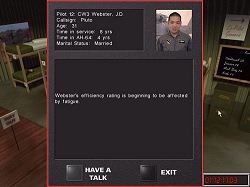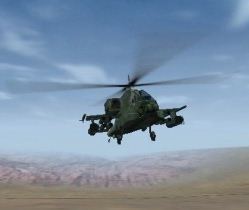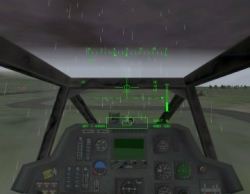| Team Alligator Interview
by Leonard "Viking1" Hjalmarson |
||||
|
Somewhere around late June, 1998, SIMIS and Mindscape/SSI released Team Apache (TA), a unique approach to a military helicopter simulation. The emphasis was on "team," and managing your team was a simulation in itself, much like the role-playing "simulations" that are popular with Japanese console gamers. In TA each member of your team had a series of aptitudes and weaknesses. The challenge was to pair pilots and gunners with complimentary skills and personalities and use them to their maximum potential. This involves being sure that you can get them enough sack time, deal with the occasional crisis, and still be able to field enough able men and machines to accomplish your mission and hopefully win the war. The outcome of specific missions and the progress of the campaign in general has effects on not only the morale issues, but can have a great deal to do with the player's status as a commander. Team management even extended to your resources and crew chief. Bringing back damaged birds every time you flew made the crew chief owly. And if you had seriously damaged choppers and no new supply, you were cannabilizing units to keep others in the air. Unlike role-playing games, though - there were no sheets of statistics to tell you what each man was capable of or how they were feeling. You had to infer that from their personal files, how they responded to you, and how well they performed in battle. Balancing all those needs was tricky but offered a unique perspective in combat simulations.
 Team Management in Team Apache
Team Apache also offered a dynamic and persistent environment. Destroyed vehicles from previous missions littered the battlefield as the unit progressed forward. Losing a pilot brought up a screen with the player/commander writing home to his family. Certain incidents were "remembered" by Operations personnel and came up to bite the player in the butt at a later date. The suspension of disbelief was achieved by appealing to the player from a personal side, as well as immersing him in a very dynamic environment of cause and effect. Apache units themselves were viewed and employed as a "big stick", with a company of 6 aircraft possessing more than enough firepower to dispatch an armored battalion. As a result, they were typically used in 5 or 6-ship elements. However, many missions required the player to divide up the company in smaller elements to "fight fires" that crop up unexpectedly. |
 The graphics engine was state of the art at the time, and was impressive to say the least. Here are some notes from Neil Mouneimne's review:  Some aspects of that detail merit special attention. For example, when you hover just above the ground, rings of "dust" are blown across the ground. From an external view, when the cockpit isn't reflecting light back at you, you can see the Apache crew inside looking around for targets. The rotors, chain gun, and optics suite are all nicely animated. There is a scattering of individual trees that you need to avoid, although they are more for show than for tactics. Entire downtown cities are modeled where you can play chicken between the skyscrapers, stalk down city streets, or land on the roof of a building and take a breather. (Fortunately, the collision detection is accurate enough that you can fly right in between buildings, lampposts, houses, and trees - as long as you don't actually hit anything) The rocket motor glow in the back of a FFAR, Hellfire, or Stinger is a nice touch. Enemy tracer fire glows brightly, streams well, and looks positively dangerous. The infrared sights are also very impressive - not only do you get the "image halo" as in Longbow 2, but you get a very believable "washout" when an explosion blinds your sights temporarily. The effect is very similar to looking a little too close to a camera flash. Does this mean the graphics are superior to Longbow 2? Yes and no. It's really apples and oranges. Team Apache boasts a much smoother framerate, has some nicer special effects, very impressive urban areas, and has that "workstation" look to it With that history in mind, we contacted the Team Alligator crew to discover where Team Alligator will build on the early product, and where it will seek to diverge or move beyond the standard previously set. Go to Page Two
|
|||
|
Copyright © 1997 - 2000 COMBATSIM.COM, INC. All Rights Reserved. Last Updated June 7th, 1999 |
||||
